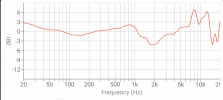Spitfire93
Member
- Joined
- Aug 28, 2022
- Messages
- 17
- Likes
- 9
are those a good counter part for HD650 ? I am looking for something with more bass/sub bass presence or should I save for something else ? Source is a Sabaj D5 if it matters.
In red is the response difference between the HD650 and HE400se (data from oratory1990):are those a good counter part for HD650 ? I am looking for something with more bass/sub bass presence or should I save for something else ? Source is a Sabaj D5 if it matters.

Yes, with EQ HE400se are capable of very impressive bass, something that HD650 just can't do! Also, very unlike HD650, HE400se have a very open and spacious sound.Of course all that changes when you use EQ, as then you can make the response whatever you want.
That to me sounds like a difference in frequency response and I am yet to hear about a case in which having spare power improves frequency response. Do you have any more information on that that's backed by measurements or controlled listening tests?After I use it with headphone amp, the bass is much more powerful and deeper. By the way, I guess "planar sound has less "impact" or "dynamic slam" than a moving coil driver" comes from the current limited headphone dongle/amp. Because planar drivers usually require more current than dynamic drivers.

 www.audiosciencereview.com
www.audiosciencereview.com
This thread also confirms there is no mysterious mechanism that will somehow translate power reserves into better sounding bass.Driving headphones properly

Driving headphones properly
What is important to drive headphone properly? In many other forums i read that not just the voltage but also the current is very important and some headphones like high current output, but usually most amplifier only strong with voltage and thats why many hard to drive phone sounds bad from...www.audiosciencereview.com
Sorry for W.O.T. but the answer is a bit more complex than it seems and am trying to explain for 'the public'.Now I'm confused about two things often said about planars:
- the "planar bass" is more powerful and deeper than a moving coil driver's bass
- planar sound has less "impact" or "dynamic slam" than a moving coil driver
I've read / heard this many times in planar reviews, most notably on headphones.com but not only there.
Don't these two statements contradict each other? Shouldn't I get more "impact" and "slam" with deeper (reaching lower frequencies) bass?
Or maybe the HE400SE is "too cheap" or rather "too conventional" (no egg-shape or huge drivers) to have the "planar sound"?
Correct, unfortunately people on subjective forums think differently and spread misinformation over and over.This thread also confirms there is no mysterious mechanism that will somehow translate power reserves into better sounding bass.
Where did you buy them, the prices in EU is all over the place, from about 160 EUR for the V2 version to the price you found.Here where I live the price has dropped to about 92€
I don't really need them but for the price... I couldn't resist. Owned them some time ago but now I'm back, with EQ these are really very good to listen.
Where did you buy them, the prices in EU is all over the place, from about 160 EUR for the V2 version to the price you found.
Cheapest seems to be rms store at 98 EUR, but then they want to add 34 EUR in shipping costs..
Ali or Amazon ?AliExpress Spain has the V2 at 87,34€ with free shipping.
It is a steal at this price.
Polish stores, for example rms.pl or mp3store.plWhere did you buy them, the prices in EU is all over the place, from about 160 EUR for the V2 version to the price you found.
Cheapest seems to be rms store at 98 EUR, but then they want to add 34 EUR in shipping costs..
Ali or Amazon ?
Ok, sorry I didn't know that aliexpress is different for each country, like amazon.nl .fr .pl. ...offers different deals.Please, read the first word in the comment you quoted.
